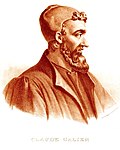Galen
Galen of Pergamum (129–199/217 AD) was a prominent Greek physician and philosopher from Pergamon, a Greek city in western Asia Minor.[1][2][3][4] He was an important medical researcher in the Roman Empire and his theories influenced Western medical science for over a thousand years.[5]
Biography
Galen was the son of Aelius Nicon, a Greek architect and builder.[4] Galen invented the 'Theory of Opposites' based on Hippocrates' Four Humours' theory, which helped develop medicine in the Roman age and again in the Middle Ages to include more natural-based medicine (rather than just religious medicine).[1][6][7]
Some of the observations he made in his books were wrong as he could only dissect animals (mostly pigs and apes) and compare them to humans due to the Roman ban on dissecting human corpses.[1][8]
Later in the Renaissance period, people such as Andreas Vesalius wrote books showing that some of what Galen said was wrong.[9] He was most famous for his discovery that proved that arteries carry blood and his dissection of a pig proved that the larynx nerves control the voice.[9] He also proved that the brain controls the body and not the heart.[9]
Galen was vital in the beginnings of natural medicine and is called the "Father of Anatomy".[10] He is also called the "Father of Medicine" second to Hippocrates.[11]
Gallery
A 19th century lithograph of Galen by Pierre Roche Vigneron.
Galen Media
A group of physicians in an image from the Vienna Dioscurides; Galen is depicted top center.
Galen (Arabic: جالينوس, romanized: Jalinus) in Kitab al-Dariyak, 1225–1250, Syria. Vienna AF 10, Syria.
References
Citations
- ↑ 1.0 1.1 1.2 Aufderheide 2003, p. 5: "Tragically, the prohibition of human dissection by Rome in 150 BC arrested this progress and few of their findings survived. By the second century AD, Galen, the Greek physician who practiced principally in Rome, popularized the humoral theory of health and disease with the aid of only two human skeletons and animal dissections but without laboratory-based opportunities for human soft (nonskeletal) tissue dissection to guide him."
- ↑ Potter & Mattingly 1999, p. 63.
- ↑ Brain 1986, p. 1.
- ↑ 4.0 4.1 Nutton 1973, pp. 158–171.
- ↑ Hankinson 2008, pp. 1–33.
- ↑ Nutton 2005, pp. 111–121.
- ↑ Kilgour 1957, pp. 105–117.
- ↑ Von Staden 1995, pp. 47–66.
- ↑ 9.0 9.1 9.2 O'Malley 1964.
- ↑ Yount 2010.
- ↑ Pasipoularides 2014, pp. 47–58.
Sources
- Aufderheide, Arthur C. (2003). The Scientific Study of Mummies. Cambridge: Cambridge University Press. ISBN 0521818265.
- Brain, Peter (1986). Galen on Bloodletting: A Study of the Origins, Development, and Validity of his Opinions, with a translation of the Three Works. Cambridge: Cambridge University Press. ISBN 0-521-32085-2.
- Hankinson, R. J. (2008). "The Man and his Work". In Hankinson, R. J. (ed.). The Cambridge Companion to Galen. Cambridge Companions to Philosophy. Cambridge: Cambridge University Press. pp. 1–33. ISBN 978-0-521-81954-1.
- Kilgour, Frederick G. (1957). "GALEN". Scientific American. 196 (3): 105–117. Bibcode:1957SciAm.196c.105K. doi:10.1038/scientificamerican0357-105. ISSN 0036-8733. JSTOR 24940775.
- Nutton, Vivian (2005). "The Fatal Embrace: Galen and the History of Ancient Medicine". Science in Context. 18 (1): 111–121. doi:10.1017/S0269889705000384. PMID 16075496. S2CID 10878807.
- Nutton, Vivian (1973). "The Chronology of Galen's Early Career". Classical Quarterly. 23 (1): 158–171. doi:10.1017/S0009838800036600. PMID 11624046. S2CID 35645790.
- O'Malley, Charles Donald (1964). Andreas Vesalius of Brussels, 1514–1564. Berkeley, CA: University of California Press.
- Pasipoularides, Ares (2014). "Galen, father of systematic medicine. An essay on the evolution of modern medicine and cardiology". International Journal of Cardiology. 172 (1): 47–58. doi:10.1016/j.ijcard.2013.12.166. PMID 24461486.
- Potter, David Stone; Mattingly, D. J. (1999). Life, Death, and Entertainment in the Roman Empire. Ann Arbor, MI: University of Michigan Press. ISBN 0-472-08568-9.
- Von Staden, H. (1995). "Anatomy as Rhetoric: Galen on Dissection and Persuasion". Journal of the History of Medicine and Allied Sciences. 50 (1): 47–66. doi:10.1093/jhmas/50.1.47. PMID 7876529.
- Yount, Lisa (2010). The Father of Anatomy: Galen and his Dissections. Berkeley Heights, NJ: Enslow Publishers, Inc. ISBN 9780766033801.








